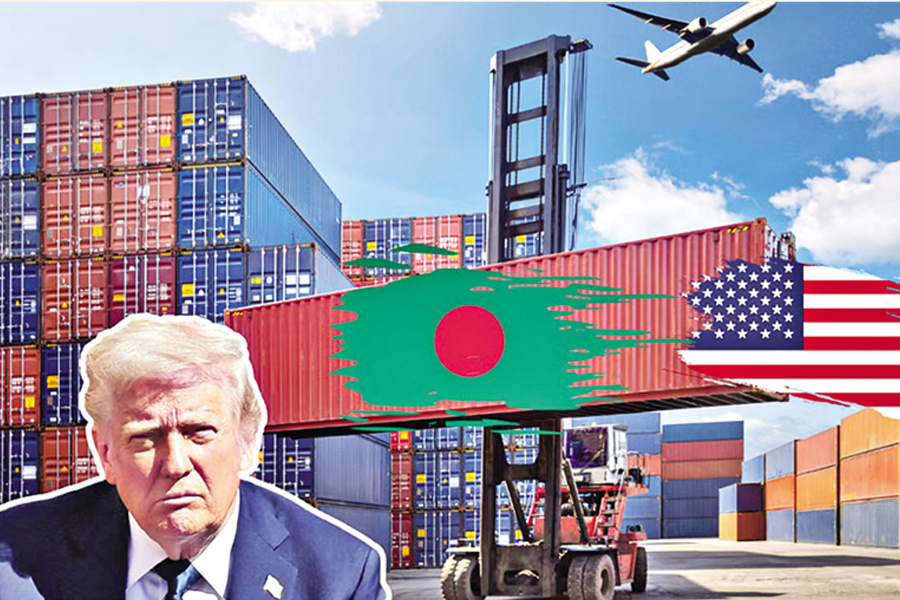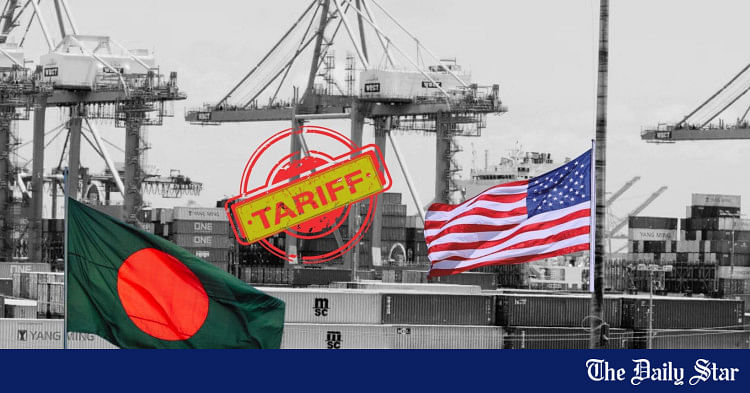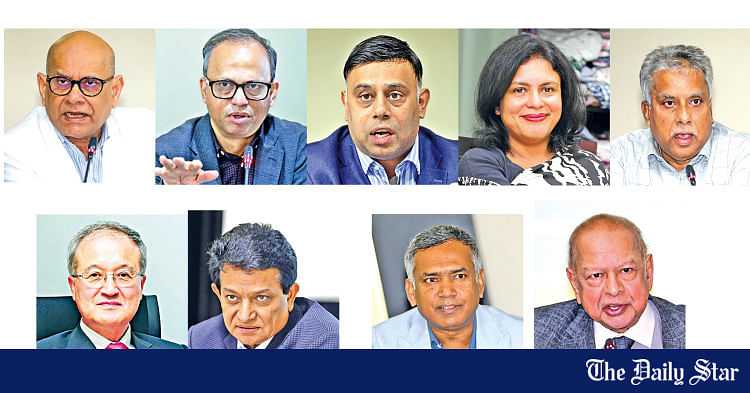- Copy to clipboard
- Thread starter
- #136
Saif
Senior Member
- Messages
- 14,314
- Reaction score
- 7,554
- Origin

- Residence

- Axis Group


Facing an uphill battle over Trump tariffs
In the light of the latest US tariff salvo on Bangladesh exports, questions are being raised over what Bangladesh can realistically offer to lower the steep duties imposed by the Trump administration. Although US officials have said that negotiation channels remain open for discussions on reciproca
Facing an uphill battle over Trump tariffs
Wasi Ahmed
Published :
Jul 15, 2025 22:56
Updated :
Jul 15, 2025 22:56

In the light of the latest US tariff salvo on Bangladesh exports, questions are being raised over what Bangladesh can realistically offer to lower the steep duties imposed by the Trump administration. Although US officials have said that negotiation channels remain open for discussions on reciprocal tariff parity, prospects of a significant turnaround appear slim, under the circumstances.
Following the imposition of a 37 per cent reciprocal tariff on April 3, Bangladesh proposed to lower import duties on a range of US-origin products. However, the move evidently fell short of meeting the Trump administration's expectations. A subsequent revision of the proposed sectoral tariff to 35 per cent also failed to shift the dynamics. For Bangladeshi exporters, who already face around 15 per cent tariff when shipping to the US -- the country's largest export destination-the newly announced 35 per cent surcharge would take the total duty to 50-51 per cent, effective from August.
Finance Adviser Dr. Salehuddin Ahmed, speaking to the press following the announcement, stated that the proposed 35 per cent tariff was not yet final and that a resolution could still be achieved through direct bilateral negotiations. Meanwhile, the Commerce Adviser, who led a small delegation for talks with the USTR earlier this week, informed the media yesterday that some time had been secured from the U.S. side to work towards a mutually acceptable position. It remains to be seen what strategic options Bangladesh has at its disposal to steer the situation in its favour.
What has complicated matters is the comparative advantage granted to Vietnam -- a key competitor in the garment sector -- which has secured a flat 20 per cent tariff on its exports to the US. This gives Vietnam a pronounced edge over Bangladesh in the American market. The trade imbalance between Bangladesh and the US currently stands at approximately $6.2 billion, while Vietnam's trade surplus with the US is a staggering $125 billion. Yet, Washington has agreed to a favourable deal with Hanoi. One likely reason is the US-Vietnam agreement that pairs the 20 per cent tariff on garments with zero-duty access for American goods into Vietnam. Additionally, while transshipment of Chinese goods through Vietnam would attract a 40 per cent tariff, this still undercuts the rates Bangladesh might face if negotiations collapse.
Other countries such as Indonesia and South Africa also appear to have struck more favourable terms than Bangladesh. Among the 14 countries listed in the latest US tariff announcements, only four are in a weaker position. Some observers argue that Bangladesh government squandered the three-month window following the initial April announcement to negotiate a better outcome. Professor Mustafizur Rahman, distinguished fellow at the Centre for Policy Dialogue (CPD), has voiced disappointment, noting that although Bangladesh was the first to begin discussions with the USTR, the outcome has been disappointing. He pointed out that negotiations have only managed a 2-percentage point reduction in the additional tariff -- an outcome that could severely damage export competitiveness.
This raises a critical question: what, if anything, can Bangladesh offer to further reduce the tariff to a more reasonable level? If, as speculated, the US is seeking to increase its exports of aircraft, cotton, food grains, LNG, and military hardware to Bangladesh in a bid to bridge the trade gap, is Dhaka prepared to respond affirmatively or take steps in that direction?
In 2024, Bangladesh exported about $8.4 billion worth of goods to the US, of which $7.34 billion came from the readymade garment sector. On the other hand, US exports to Bangladesh stood at just $2.2 billion, leaving a trade gap of $6.2 billion. Would a pledge from Bangladesh to import more American goods suffice? Could the government consider granting zero-tariff access to US exports across the board?
The Vietnam deal is attractive on paper. But the fact remains Vietnam cannot meet the total demand for garments in the US. Bangladesh, unlike Vietnam, has pursued negotiations under a multilateral framework, hoping to secure lower duties based on WTO's Most Favoured Nation (MFN) principles. However, the US appears more inclined towards bilateral deals that blend trade considerations with strategic partnerships.
If the worst-case scenario unfolds and Bangladesh is subjected to an effective tariff rate exceeding 50 per cent, many suppliers -- who currently export between 40 and 80 per cent of their output to the US -- could be pushed to the brink. With profit margins in the apparel industry already wafer-thin and operational costs steadily rising, such a tariff hike would make it increasingly difficult for many exporters to sustain their businesses. At the current 15 per cent rate, the apparel sector already pays over $1.0 billion annually in tariffs. A hike to more than 50 per cent could result in significantly higher losses -- not just for Bangladeshi exporters, but also for US brands and consumers. Higher costs at the retail end could trigger inflationary pressures and supply chain disruptions.
It is important to recognise that this is not just a trade negotiation -- it is entangled with geopolitics. The limited political engagement between Dhaka and Washington may be working against Bangladesh's interests. Without closer ties to the Trump administration's core political constituencies, trade negotiations alone may not suffice. Bangladesh must urgently recalibrate its strategy. This includes leveraging US-based lobby groups, engaging American retailers, and reaching out to sourcing associations who rely on Bangladeshi goods. Business diplomacy needs to work in tandem with traditional diplomacy to navigate this complex situation.
At a time when global trade dynamics are shifting and geopolitical alliances are reshaping trade policies, Bangladesh cannot afford to be reactive. The stakes are high, and the time to act decisively is now.
Wasi Ahmed
Published :
Jul 15, 2025 22:56
Updated :
Jul 15, 2025 22:56
In the light of the latest US tariff salvo on Bangladesh exports, questions are being raised over what Bangladesh can realistically offer to lower the steep duties imposed by the Trump administration. Although US officials have said that negotiation channels remain open for discussions on reciprocal tariff parity, prospects of a significant turnaround appear slim, under the circumstances.
Following the imposition of a 37 per cent reciprocal tariff on April 3, Bangladesh proposed to lower import duties on a range of US-origin products. However, the move evidently fell short of meeting the Trump administration's expectations. A subsequent revision of the proposed sectoral tariff to 35 per cent also failed to shift the dynamics. For Bangladeshi exporters, who already face around 15 per cent tariff when shipping to the US -- the country's largest export destination-the newly announced 35 per cent surcharge would take the total duty to 50-51 per cent, effective from August.
Finance Adviser Dr. Salehuddin Ahmed, speaking to the press following the announcement, stated that the proposed 35 per cent tariff was not yet final and that a resolution could still be achieved through direct bilateral negotiations. Meanwhile, the Commerce Adviser, who led a small delegation for talks with the USTR earlier this week, informed the media yesterday that some time had been secured from the U.S. side to work towards a mutually acceptable position. It remains to be seen what strategic options Bangladesh has at its disposal to steer the situation in its favour.
What has complicated matters is the comparative advantage granted to Vietnam -- a key competitor in the garment sector -- which has secured a flat 20 per cent tariff on its exports to the US. This gives Vietnam a pronounced edge over Bangladesh in the American market. The trade imbalance between Bangladesh and the US currently stands at approximately $6.2 billion, while Vietnam's trade surplus with the US is a staggering $125 billion. Yet, Washington has agreed to a favourable deal with Hanoi. One likely reason is the US-Vietnam agreement that pairs the 20 per cent tariff on garments with zero-duty access for American goods into Vietnam. Additionally, while transshipment of Chinese goods through Vietnam would attract a 40 per cent tariff, this still undercuts the rates Bangladesh might face if negotiations collapse.
Other countries such as Indonesia and South Africa also appear to have struck more favourable terms than Bangladesh. Among the 14 countries listed in the latest US tariff announcements, only four are in a weaker position. Some observers argue that Bangladesh government squandered the three-month window following the initial April announcement to negotiate a better outcome. Professor Mustafizur Rahman, distinguished fellow at the Centre for Policy Dialogue (CPD), has voiced disappointment, noting that although Bangladesh was the first to begin discussions with the USTR, the outcome has been disappointing. He pointed out that negotiations have only managed a 2-percentage point reduction in the additional tariff -- an outcome that could severely damage export competitiveness.
This raises a critical question: what, if anything, can Bangladesh offer to further reduce the tariff to a more reasonable level? If, as speculated, the US is seeking to increase its exports of aircraft, cotton, food grains, LNG, and military hardware to Bangladesh in a bid to bridge the trade gap, is Dhaka prepared to respond affirmatively or take steps in that direction?
In 2024, Bangladesh exported about $8.4 billion worth of goods to the US, of which $7.34 billion came from the readymade garment sector. On the other hand, US exports to Bangladesh stood at just $2.2 billion, leaving a trade gap of $6.2 billion. Would a pledge from Bangladesh to import more American goods suffice? Could the government consider granting zero-tariff access to US exports across the board?
The Vietnam deal is attractive on paper. But the fact remains Vietnam cannot meet the total demand for garments in the US. Bangladesh, unlike Vietnam, has pursued negotiations under a multilateral framework, hoping to secure lower duties based on WTO's Most Favoured Nation (MFN) principles. However, the US appears more inclined towards bilateral deals that blend trade considerations with strategic partnerships.
If the worst-case scenario unfolds and Bangladesh is subjected to an effective tariff rate exceeding 50 per cent, many suppliers -- who currently export between 40 and 80 per cent of their output to the US -- could be pushed to the brink. With profit margins in the apparel industry already wafer-thin and operational costs steadily rising, such a tariff hike would make it increasingly difficult for many exporters to sustain their businesses. At the current 15 per cent rate, the apparel sector already pays over $1.0 billion annually in tariffs. A hike to more than 50 per cent could result in significantly higher losses -- not just for Bangladeshi exporters, but also for US brands and consumers. Higher costs at the retail end could trigger inflationary pressures and supply chain disruptions.
It is important to recognise that this is not just a trade negotiation -- it is entangled with geopolitics. The limited political engagement between Dhaka and Washington may be working against Bangladesh's interests. Without closer ties to the Trump administration's core political constituencies, trade negotiations alone may not suffice. Bangladesh must urgently recalibrate its strategy. This includes leveraging US-based lobby groups, engaging American retailers, and reaching out to sourcing associations who rely on Bangladeshi goods. Business diplomacy needs to work in tandem with traditional diplomacy to navigate this complex situation.
At a time when global trade dynamics are shifting and geopolitical alliances are reshaping trade policies, Bangladesh cannot afford to be reactive. The stakes are high, and the time to act decisively is now.



